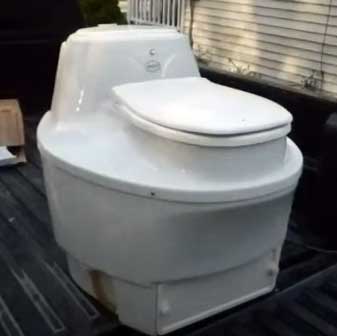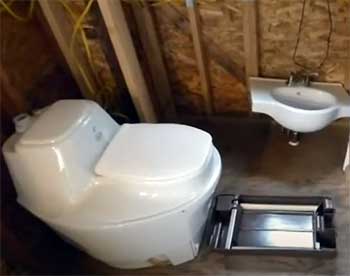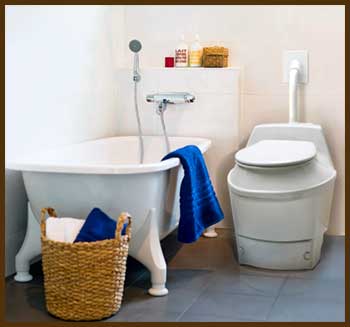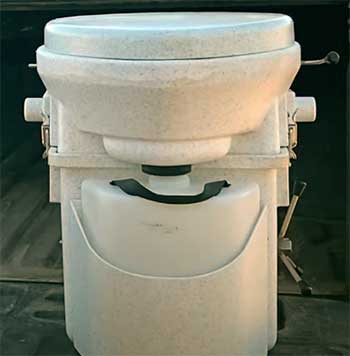I’m sold on the BioLet composting toilet, and you should be too. It’s a game-changer for anyone craving eco-friendly living without sacrificing convenience. Whether you’re off-grid in a tiny home, RV camping, or just want to cut water waste, this toilet delivers.
It’s not perfect—nothing is—but its blend of sustainability, ease, and innovation makes it a standout. From my own experience, it’s transformed how I think about waste management. Ready to rethink your bathroom?
Let’s explore why the BioLet is worth your investment.
My Journey With The BioLet Composting Toilet

When I first considered a composting toilet, I’ll admit I was skeptical.
The idea of managing my own waste sounded like a messy, smelly hassle.
But living in a tiny home with no septic system forced my hand, and the BioLet 55 caught my eye.
Its sleek design and promise of a flush-toilet feel without water hooked me.
I ordered it, nervously anticipating a science experiment gone wrong.
Installation was surprisingly straightforward. With basic handyman skills, I had it set up in about two hours. The manual was clear, guiding me through venting options—mine runs through an exterior wall.
The BioLet 55’s automatic features, like the mixing system and quiet fan, made me feel like I was stepping into the future. Sitting on it the first time, I braced for weirdness, but it felt like a regular toilet. The trap doors opened smoothly, and the compost cover hid everything from view.
No odors, no drama.
After six months, I’m a convert. The fan keeps smells at bay, and the warm seat (thanks to a small heater) is a cozy bonus in my chilly cabin. Emptying the humus tray—my biggest fear—wasn’t gross.
After eight weeks, the waste looked like potting soil, and I added it to my flower beds (not veggies, I’m not there yet). Maintenance is minimal, just adding mulch weekly, and the toilet handles my household of two with ease.
It’s not just a toilet; it’s a lifestyle shift that makes me feel good about my environmental footprint.
What Makes The BioLet Shine?
- Eco-Friendly to the Core

The BioLet’s biggest win is its green cred.
It uses zero water, which is huge when you consider that traditional toilets guzzle thousands of gallons yearly.
I love knowing I’m not flushing drinking water down the drain.
The composting process turns waste into nutrient-rich humus, perfect for non-edible plants.
It’s like giving back to the earth instead of burdening sewage systems with chemicals. For anyone aiming to live sustainably, this toilet is a no-brainer.
- Feels Like a Regular Toilet
I was worried the BioLet would feel alien, but it mimics a flush toilet beautifully. The seat is comfortable, and the automatic trap doors and mixing system make it user-friendly. You sit, do your thing, and the toilet handles the rest.
The compost cover ensures you never see the waste, which is a mental hurdle I didn’t want to cross. It’s clean, tidy, and oddly luxurious for something so eco-conscious.
- Low Maintenance, High Convenience
Maintaining the BioLet is easier than I expected. The automatic mixer and fan do most of the work, breaking down waste and evaporating liquid. I add a half-cup of BioLet-approved mulch after each use, which keeps things composting smoothly.
The humus tray needs emptying only once or twice a year for my small household, and the process is quick. No pipes, no clogs, no plungers—just a straightforward system that respects my time.
- Space-Saving and Versatile
Living in a tiny home, space is gold. The BioLet 55 fits perfectly in my compact bathroom, and its self-contained design means no septic tank or plumbing. It’s ideal for RVs, boats, or cabins too.
I’ve even heard of folks installing it in basements or pool houses. Wherever you need a toilet without traditional infrastructure, the BioLet delivers without hogging room.
- Energy Efficiency
The BioLet’s electric components—like the fan and heaters—use minimal power. My electricity bill barely noticed. You can adjust the thermostat based on usage, and if you’re away for a few days, just turn it off.
For off-grid folks, the BioLet 30NE is a non-electric option, though I love the automation of my 55. Either way, it’s designed to sip energy, not guzzle it.
The Downsides of The BioLet
- Pricey Upfront Cost

Let’s talk money.
The BioLet isn’t cheap, with models like the 55 or 65 ranging from $1,900 to $3,000.
That’s a big pill to swallow compared to a $200 flush toilet.
I justified it by calculating long-term savings—no water bills, no septic installation, no plumbing repairs.
Still, the initial hit stings, especially if you’re on a tight budget. It’s an investment, and you need to be ready for the upfront commitment.
- Manual Waste Handling
You can’t escape it: you’ll handle composted waste. For me, emptying the humus tray every six months isn’t a dealbreaker, but if the idea of scooping soil-like material grosses you out, think twice.
It’s not as bad as it sounds—think gardening, not porta-potty—but it’s a mental shift. If you’re squeamish, this might be the BioLet’s biggest con.
- Temperature Sensitivity
The BioLet needs warmth to compost efficiently. In my insulated cabin, it’s fine, but in colder climates, composting slows down below 55°F. I keep my bathroom at 65°F, which works, but unheated spaces might need an insulated box or extra heating.
It’s a consideration if you’re in a seasonal cabin or RV with fluctuating temperatures.
- Replacement Parts Can Be Tricky
I haven’t needed parts yet, but I’ve heard grumbles about BioLet’s replacement process. Some users say tracking down specific components is a hassle, and shipping from Sweden can take time.
The toilets are built tough, so this might not hit you, but it’s worth knowing. Keep the manual handy and register your warranty just in case.
How The BioLet Stacks Up Against The Competition?
- Nature’s Head: Rugged but Hands-On

Nature’s Head is a favorite among RV and boat owners for its durability and compact design.
I tried one at a friend’s camper, and it’s solid, with a urine-diverting system that keeps solids dry.
But it’s more manual—you crank the agitator yourself, and emptying the solids bin feels less polished than the BioLet’s automated system.
Nature’s Head is cheaper, around $1,000, but lacks the flush-toilet vibe.
If you’re okay with a bit more elbow grease and want something portable, it’s a strong contender, but I prefer the BioLet’s hands-off approach.
- Separett Villa: Sleek but Complex
The Separett Villa is all about style and urine diversion. I checked one out at a tiny home expo, and its modern look is tempting. It separates liquid and solid waste, which reduces odor and simplifies composting.
However, you need to manage the urine tank separately, which can be a chore if you don’t have a gray water system. Priced around $900-$1,100, it’s more affordable than the BioLet, but installation is trickier due to the plumbing needs.
For urban settings, it’s great, but I like the BioLet’s self-contained ease for my off-grid setup.
- Sun-Mar: Affordable but Basic
Sun-Mar toilets, like the Excel, are budget-friendly at $1,200-$1,600. I visited a cabin with one, and it gets the job done with a rotating drum for composting. But it feels less refined—more like a barrel than a toilet.
The manual crank and occasional liquid overflow issues made it less appealing. It’s a good pick for cost-conscious buyers or seasonal use, but the BioLet’s automation and polish make it feel like a luxury upgrade for full-time living.
- HomeBiogas Bio-Toilet: Innovative but Niche
The HomeBiogas Bio-Toilet intrigued me with its waste-to-energy twist, turning waste into biogas for cooking or heating. I read up on it for my cabin, but it’s a niche choice. Priced around $1,300, it requires more space and maintenance to manage the biogas system.
For eco-geeks with room to spare, it’s exciting, but the BioLet’s simplicity and focus on composting won me over for everyday use.
Keeping Your BioLet In Top Shape
- Regular Mulch Additions
To keep your BioLet humming, add mulch consistently. I use BioLet-approved peat moss and pine shavings mix, about a half-cup after each use or a quart per person weekly. It fuels aerobic decomposition and keeps odors down.
Don’t skimp here—using non-approved mulch can clog the mixer or slow composting. I buy in bulk from BioLet’s site to save hassle, and I microwave the mulch for 30-45 seconds to kill any bug larvae. Trust me, you don’t want critters in there.
- Monitor Temperature and Ventilation
Composting loves warmth, so keep your bathroom above 55°F. I set my heater to 65°F, which is perfect. The BioLet’s fan handles ventilation, pulling air outward to eliminate smells. Check the fan monthly for dust buildup—I use a soft brush to clean it.
If you’re in a humid area, consider an optional 12VDC fan for extra airflow. I keep a window cracked in summer to help, but avoid opening it too wide, as it can push odors back inside.
- Empty the Humus Tray Properly
Emptying the humus tray is the big maintenance task, but it’s not daunting. For my BioLet 55, I do it every six months. Crank the handle in reverse to move compost to the finishing drawer, let it sit for 6-8 weeks, and it’s ready.
Wear gloves, scoop it into a compost bin or non-edible garden bed, and you’re done. Don’t rush it—fully composted waste looks like soil and smells earthy. If it’s still wet, give it more time.
- Clean the Toilet Surface
The BioLet’s polished polystyrene is a breeze to clean. I wipe the seat and exterior weekly with a damp cloth and mild soap. The removable seat makes deep cleaning simple.
Avoid harsh chemicals—they can damage the finish and upset the composting balance. If you notice residue in the bowl (rare for me), a quick scrub with a soft brush does the trick. Keep it clean, and it’ll feel like new.
- Check Electrical Components
For electric models like mine, check the fan, heaters, and thermostat monthly. I unplug the unit, inspect for loose wires, and ensure the float switch (which detects excess liquid) moves freely.
If you’re away for over two days, turn off the toilet to save power and prevent over-heating. I’ve had no issues, but staying proactive keeps the system reliable.
Frequently Asked Questions (FAQ)
Composting toilets like the BioLet aren’t flawless. The upfront cost can hit hard—expect to spend $1,900-$3,000, way more than a standard toilet. You’ll also need to handle composted waste, which can be off-putting if you’re squeamish. They’re temperature-sensitive; cold climates slow composting without extra heating. Replacement parts can be tough to source, and some models need electricity, which isn’t ideal for fully off-grid setups. Lastly, they require regular maintenance, like adding mulch, which might feel like a chore if you’re used to flush-and-forget systems.
A composting toilet, like the BioLet, uses aerobic decomposition to turn waste into compost without water, relying on microorganisms, mulch, and air circulation. A bio toilet is a broader term, often including systems that treat waste biologically, like incinerating or chemical toilets. Some bio toilets produce biogas, like the HomeBiogas system, while composting toilets focus on creating humus. The BioLet is a true composting toilet, prioritizing eco-friendly waste breakdown over other bio-processing methods.
Yes, you can toss toilet paper into the BioLet. It breaks down alongside waste, thanks to the composting process. I use standard TP without issues, though thinner brands compost faster. Just avoid overloading the system with excessive paper, as it can slow decomposition. Never put feminine products or non-biodegradable items in there—they clog the system and mess with composting. Stick to TP, and you’re golden.
Dumping BioLet waste depends on your setup. Fully composted waste—looking like soil after 6-8 weeks—can go into a compost bin or non-edible garden beds, like flower or ornamental plots. I add mine to my roses, and they thrive. Never use it on edible crops due to pathogen risks. If it’s not fully composted, dispose of it in an approved waste receptacle, like a sealed trash bag at a dump station. Check local regulations, as some areas have specific rules for human waste.
Final Thoughts On The BioLet Composting Toilet
The BioLet composting toilet has won me over, and I’m betting it’ll win you too. It’s not just a toilet—it’s a step toward a greener, smarter lifestyle. From its eco-friendly design to its surprising convenience, it’s perfect for tiny homes, RVs, or anyone wanting to ditch water waste.
Sure, it has quirks, but the benefits far outweigh them. If you’re ready to embrace sustainable living with a toilet that feels like home, grab a BioLet and join the composting revolution.
